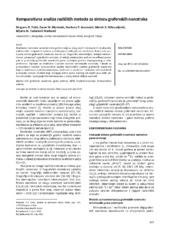Приказ основних података о документу
Comparative Analysis of Different Methods for Graphene Nanoribbon Synthesis
| dc.creator | Tošić, Dragana | |
| dc.creator | Marković, Zoran M. | |
| dc.creator | Jovanović, Svetlana P. | |
| dc.creator | Milosavljević, Momir | |
| dc.creator | Todorović-Marković, Biljana | |
| dc.date.accessioned | 2018-03-01T23:19:32Z | |
| dc.date.available | 2018-03-01T23:19:32Z | |
| dc.date.issued | 2013 | |
| dc.identifier.issn | 0367-598X | |
| dc.identifier.uri | https://vinar.vin.bg.ac.rs/handle/123456789/5427 | |
| dc.description.abstract | Graphene nanoribbons (GNRs) are thin strips of graphene that have captured the interest of scientists due to their unique structure and promising applications in electronics. This paper presents the results of a comparative analysis of morphological properties of graphene nanoribbons synthesized by different methods. Various methods have been reported for graphene nanoribons synthesis. Lithography methods usually include electron-beam (e-beam) lithography, atomic force microscopy (AFM) lithography, and scanning tunnelling microscopy (STM) lithography. Sonochemical and chemical methods exist as well, namely chemical vapour deposition (CVD) and anisotropic etching. Graphene nanoribbons can also be fabricated from unzipping carbon nanotubes (CNTs). We propose a new highly efficient method for graphene nanoribbons production by gamma irradiation of graphene dispersed in cyclopentanone (CPO). Surface morphology of graphene nanoribbons was visualized with atomic force and transmission electron microscopy. It was determined that dimensions of graphene nanoribbons are inversely proportional to applied gamma irradiation dose. It was established that the narrowest nanoribbons were 10-20 nm wide and 1 nm high with regular and smooth edges. In comparison to other synthesis methods, dimensions of graphene nanoribbons synthesized by gamma irradiation are slightly larger, but the yield of nanoribbons is much higher. Fourier transform infrared spectroscopy was used for structural analysis of graphene nanoribbons. Results of photoluminescence spectroscopy revealed for the first time that synthesized nanoribbons showed photoluminescence in the blue region of visible light in contrast to graphene nanoribbons synthesized by other methods. Based on disclosed facts, we believe that our synthesis method has good prospects for potential future mass production of graphene nanoribbons with uniform size, as well as for future investigations of carbon nanomaterials for applications in optoelectronics and biological labeling. | en |
| dc.relation | info:eu-repo/grantAgreement/MESTD/Basic Research (BR or ON)/172003/RS// | |
| dc.rights | openAccess | en |
| dc.source | Hemijska industrija | en |
| dc.subject | Graphene nanoribbons | en |
| dc.subject | Gamma irradiation | en |
| dc.subject | AFM | en |
| dc.subject | Photoluminescence | en |
| dc.subject | Comparative analysis | en |
| dc.title | Comparative Analysis of Different Methods for Graphene Nanoribbon Synthesis | en |
| dc.type | article | en |
| dcterms.abstract | Марковић Зоран; Тошић Драгана; Милосављевић Момир; Тодоровић-Марковић Биљана; Јовановиц, Светлана П.; | |
| dc.citation.volume | 67 | |
| dc.citation.issue | 1 | |
| dc.citation.spage | 147 | |
| dc.citation.epage | 156 | |
| dc.identifier.wos | 000317808000017 | |
| dc.identifier.doi | 10.2298/HEMIND120403056T | |
| dc.citation.rank | M23 | |
| dc.identifier.scopus | 2-s2.0-84875009121 | |
| dc.identifier.fulltext | https://vinar.vin.bg.ac.rs//bitstream/id/13377/5423.pdf |

